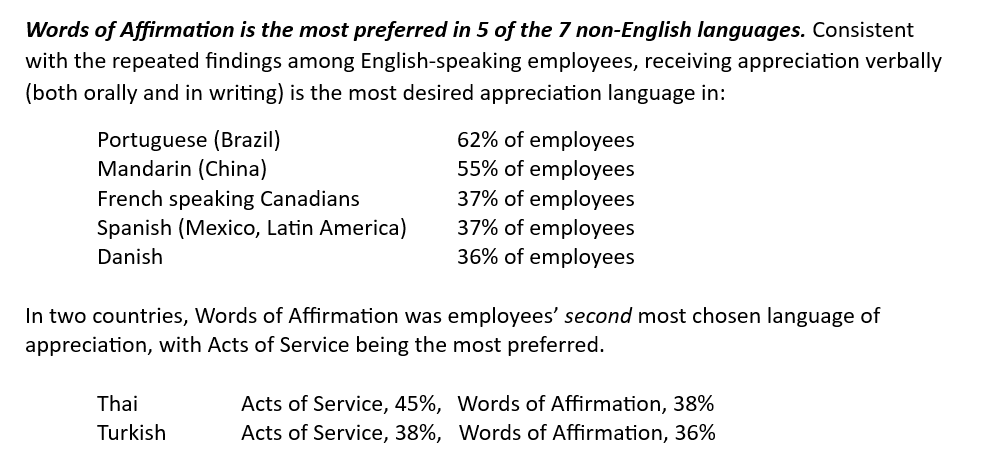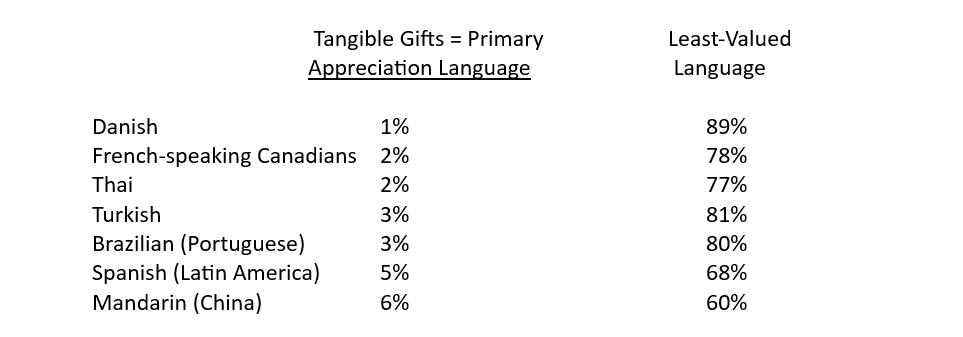Appreciation Preferences Across Cultures: What We’ve Learned from MBAI Results in 7 Languages
The importance of communicating appreciation in the workplace has become a common topic in the past few years – both in relation to combining personalized appreciation with traditional recognition activities, and sometimes as an alternative model of increasing employee engagement.
As the world of work has become significantly more globalized, the question has been raised whether employees in various cultures desire appreciation differently. In our work over the past decade in applying the concepts of the five love languages to work-based relationships, we have primarily focused on English-speaking countries: the U.S., Canada, the U.K., Australia, and New Zealand. In prior research studies, we have explored how appreciation preferences differ across generations, industries, and remote versus on-site employees.
Appreciation Preferences for English-speaking Employees
The pattern for English-speaking employees (and predominately, North Americans) has been quite consistent over time, with Words of Affirmation being repeatedly preferred by the most employees (around 46%). This has been true across generations, work settings, and industries, with just a few minor exceptions. So, if you are unsure of how a colleague wants to be appreciated, using words is your best guess (but do so privately, many do not like affirmation in front of others).
Generally speaking, Quality Time is the second most desired way of being appreciated by 26% of the workforce. However, a generational shift has occurred regarding what type of time individuals desire: older (50 years old +) prefer individualized, focused time with their supervisor, while younger team members value time with their peers more – for example, going out to lunch together.
Acts of Service, which is demonstrated by helping a colleague on a task (especially on a time-limited project, or when the activity at the front reception desk is busy), is the third most chosen language of appreciation (except in more hands-on industries such as construction and the military, where it is valued more). On average, Acts of Service is chosen by 21% of the workforce as the way they feel valued by their coworkers and supervisor.
Consistently, Tangible Gifts is different than compensation. In this context, they are small items which show you are getting to know your colleagues and what they like (for example, their favorite type of coffee, or what sports team they follow). This has been the least chosen appreciation language, by only 7% of English-speaking employees. (Note that this does not involve raises or bonuses, which is between the employer and employee.) Employees often report that, if they never hear anything positive, no one stops by to see how they are doing, or people don’t offer assistance when they are overloaded, then a gift seems quite superficial.
The language of Physical Touch is addressed in our model because it does occur (largely as spontaneous celebration with a high five, fist bump or congratulatory handshake) but it is not included in our assessment and research because it is chosen by less than 1% of employees as their preferred way of receiving appreciation.
Appreciation Preferences for Other Languages and Cultures
Over time, we responded to requests to have our online assessment in additional languages, so we have worked with both linguistic and cultural translators to create versions in Spanish (for Mexico and Latin America), French (Canadian), Portuguese (for Brazilians), Danish, Mandarin, Thai, and Turkish. Recently, we analyzed the results for over 2,000 employees who have taken the assessment in their native language.
We found the following patterns to be interesting.
Interestingly, this is similar to findings of a previous study of over 950 Singaporean employees. In Singapore, English is the primary language used in business communication, but the culture is primarily Asian (with an American-Western European overlay). For those employees, they chose Acts of Service as their primary language of appreciation 39% of the time, with Words of Affirmation being secondary but essentially equivalent, at 37%.
Quality Time is not highly desired in 3 of the non-English languages. Quality Time is typically the second most desired way of being shown appreciation by English-speaking employees (by 26% or one of every four). But in three cultures, Quality Time is desired significantly less: Mandarin (China), by only 8% of employees; Portuguese (Brazil), by 14%; and Thai, by 15%.
One intervening variable may be needed to be considered for the Brazilian and Thai employees – their work setting was in manufacturing, so this should be investigated further.
Tangible Gifts are consistently the least desired way of being shown appreciation across all languages. While Tangible Gifts has consistently been chosen by 6 – 7 % of English-speaking North Americans, these results demonstrate that gifts are desired even less by those in different countries. Equally striking is how often Tangible Gifts are identified as individuals’ least valued appreciation language.
The implications seem to be clear for companies based in and multinational corporations with work sites in these cultures – attempting to solely use tangible gifts as a means of communicating appreciation to their employees will clearly miss the mark. It should be noted again, however, that recognition and reward strategies may motivate employees to increase desired behaviors and reach goals – but what motivates employees and what makes them feel valued as an individual are two separate dynamics.
Conclusion
Both research findings and practical experiences continue to validate the belief that employees desire to be valued and appreciated, and this has been shown to be a key factor impacting levels of employee engagement and employee turnover rates. Recent trends seem to be finding that a combination of employee recognition and rewards for achieving goals along with authentic appreciation at a personal level may be the best practice for creating a positive and effective workplace culture.
Not surprisingly, the desired ways to be shown appreciation at work have both common trends and differences across cultures and languages spoken. This issue needs ongoing research in additional cultures and to account for possible influence by the type of work setting in the various cultures.
But the key take-away is clear: explore how your employees desire to be appreciated and train leaders and team members to show appreciation in the ways most meaningful to their coworkers. A positive workplace culture which reaches its goals will follow!
* * * * *
NOTE: This article has been accepted for publication in Essentials for Recognition and Rewards, and is scheduled to be published in April 2024.
Categories 5 Languages of Appreciation in the Workplace, Appreciation, Cultural differences, Employee engagement, Managing By Appreciation, MBA Inventory



